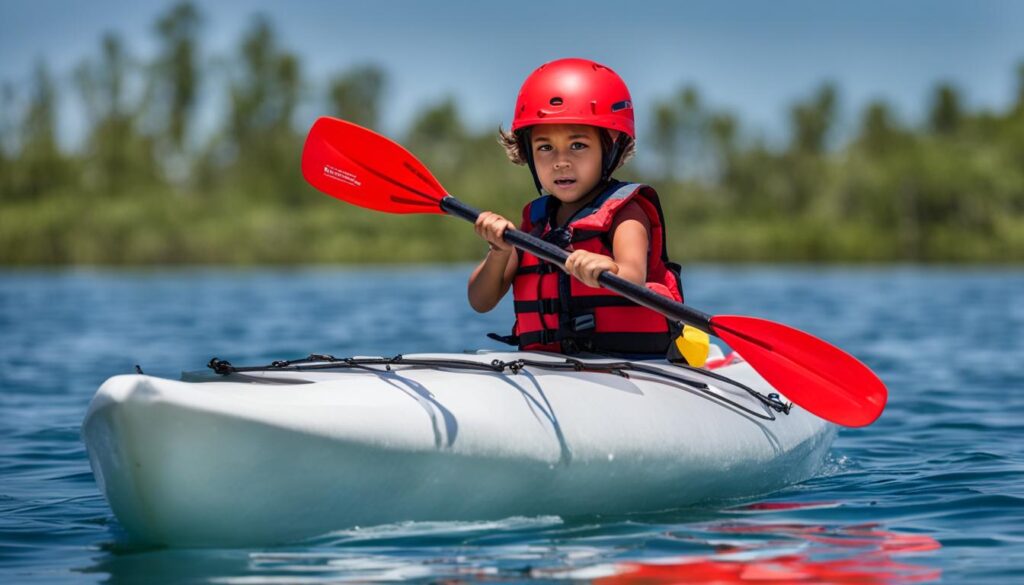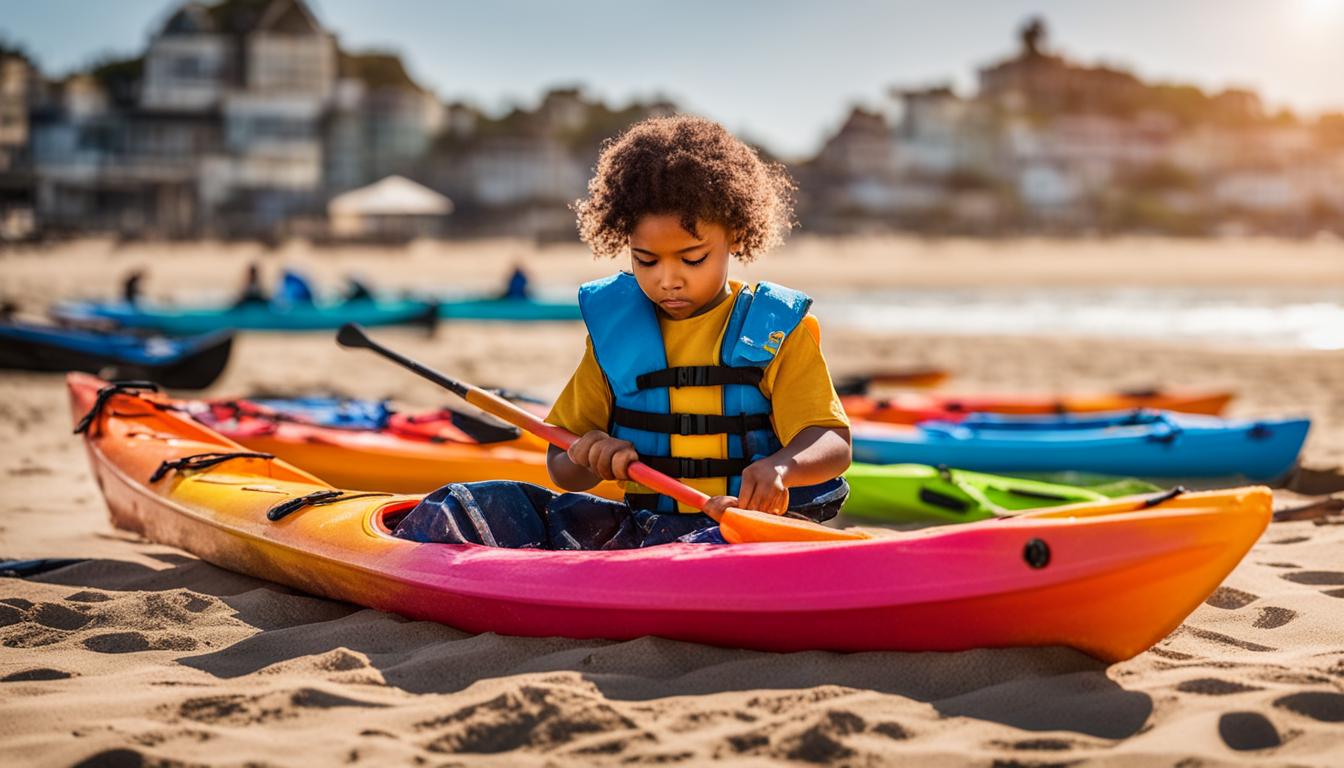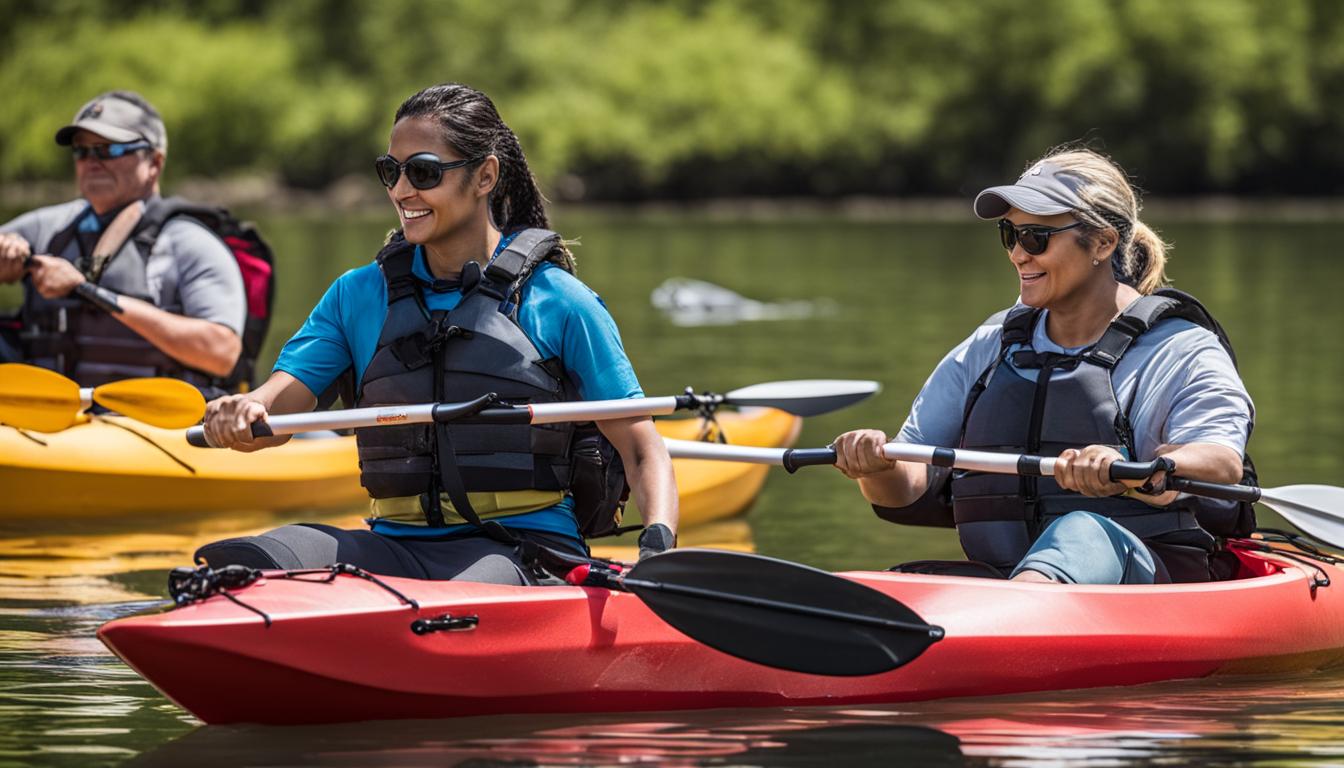Learning rescue techniques is important for kayaking safety, especially for kids. In this article, we will explore three essential kayak rescue techniques that kids can learn: the T Rescue, the Heel Hook Rescue, and the Paddle Float Self Rescue. These techniques will equip young paddlers with the skills to handle emergency situations while kayaking.
When it comes to kayaking, safety should always be a priority. By teaching kids these kayak rescue methods, we can ensure that they are prepared to handle any unexpected situations that may arise while out on the water. Whether it’s a capsized kayak or an emergency situation, these techniques will give kids the knowledge and confidence to react appropriately and stay safe.
Throughout this article, we will provide detailed explanations and step-by-step instructions for each rescue technique. It’s important to note that different techniques may be more suitable for different situations, so it’s essential to practice and understand the strengths and limitations of each method. With practice and proper training, kids can become proficient in these rescue techniques and enhance their overall kayaking experience.
Key Takeaways:
- Kayak rescue techniques are crucial for the safety of kids in kayaks
- The T Rescue, Heel Hook Rescue, and Paddle Float Self Rescue are three essential techniques
- Practice these rescue techniques in calm, warm water to build confidence and skill
- Know the limitations and make smart decisions when kayaking, such as not going out alone in rough water
- Different kayaks may require different rescue techniques, so practice in the specific kayak being used
T Rescue: Essential Kayak Overturn Techniques for Kids
When it comes to young paddlers’ rescue training, the T Rescue is a crucial technique to learn. This rescue method is used when there is at least one other kayaker nearby to assist. By understanding and practicing the T Rescue, kids can develop the skills to safely recover from a capsized kayak.
Here is how the T Rescue works:
- The rescuer paddles up to the capsized kayak, forming a “T” shape with their own kayak.
- The capsized paddler swims to the opposite end of their kayak, away from the rescuer.
- The rescuer lifts the end of the capsized kayak out of the water to allow water to drain from the cockpit.
- Once the cockpit is mostly water-free, the rescuer stabilizes the kayak for the capsized paddler to re-enter.
This technique not only helps rescue the capsized paddler but also teaches coordination and teamwork between young kayakers. By practicing the T Rescue, kids can build confidence and be better prepared for unexpected situations on the water.

| Advantages of the T Rescue | Considerations for Young Paddlers |
|---|---|
|
|
The Heel Hook Rescue
When it comes to kayak capsize recovery skills for kids, the Heel Hook Rescue is an essential technique to learn. This rescue method is particularly useful for young paddlers who may not have as much upper body strength as adults. The Heel Hook Rescue allows them to quickly and effectively get back into their kayak, ensuring their safety in emergency situations.
In the Heel Hook Rescue, the rescuer follows the same initial steps as in the T Rescue. They stabilize the capsized kayak by forming a “T” shape with their own kayak. However, instead of re-entering the kayak from the side, the capsized paddler lays on their back alongside the kayak and raises their leg, hooking their heel onto the cockpit. Using the strength of their legs, they pull themselves up and onto the kayak, then turn and drop down into the seat.
This technique leverages the strong leg muscles, making it easier for kids to regain stability and control of their kayak. By mastering the Heel Hook Rescue, young paddlers can confidently handle unexpected kayak overturns, knowing they have the skills to recover quickly and efficiently.
Remember, practicing these emergency handling skills for kids in kayaks is crucial. The more they practice, the more comfortable and confident they will become in executing the Heel Hook Rescue and other rescue techniques. It is important to create a safe learning environment for children, with warm, calm water and proper supervision. With regular practice and the right training, kids can develop the necessary skills to handle kayak capsize situations with ease.
Tips for mastering the Heel Hook Rescue:
- Start by practicing in calm, shallow water with an experienced instructor or adult.
- Make sure the capsized paddler is familiar with the kayak’s cockpit and can easily hook their heel onto it.
- Encourage the capsized paddler to use their legs to generate power and pull themselves up onto the kayak.
- Emphasize the importance of practicing the Heel Hook Rescue regularly to build muscle memory and increase confidence.
Paddle Float Self Rescue
Teaching kids kayak self-rescue is a crucial aspect of ensuring their safety on the water. One important technique they can learn is the Paddle Float Self Rescue. This rescue method is specifically designed for situations where a child capsizes their kayak while kayaking alone. By equipping themselves with a paddle float and a bilge pump, they can confidently handle emergency situations and get back into their kayak.
The Paddle Float Self Rescue involves stabilizing the capsized kayak using the paddle float. The child then re-enters the kayak from the water and utilizes the bilge pump to remove any water from the cockpit. This technique requires practice and proper instruction to ensure its effective execution. By mastering this rescue method, children can develop the necessary skills to handle unexpected situations while kayaking alone.
While teaching kids the Paddle Float Self Rescue, it’s crucial to emphasize the importance of communication, preparedness, and maintaining calm in emergency scenarios. By instilling these values and providing them with the necessary training, children can become confident and responsible kayakers, capable of responding to any potential challenges they may face on the water. Safety should always be the top priority.

| Benefits of Paddle Float Self Rescue | Considerations |
|---|---|
|
|
Practice Makes Perfect
Now that you’ve learned about essential kayak rescue techniques for kids, it’s time to put them into practice. Regular training and rescue scenario practice in warm, calm water will help young paddlers build confidence and develop the necessary skills for handling rescues in more challenging conditions.
When it comes to rescue training for young kayakers, it’s important to create a safe and controlled environment. Start by practicing the T Rescue, Heel Hook Rescue, and Paddle Float Self Rescue in calm water with minimal currents. This will allow kids to focus on mastering the techniques without additional challenges.
In addition to practicing the various rescue techniques, it’s crucial for young paddlers to understand the importance of making smart decisions while kayaking. Teach them to assess the water and weather conditions before heading out, and to never go kayaking alone in rough water. By instilling these safety habits early on, kids can minimize the risk of capsizing and the need for rescues.
It’s also worth noting that different types of kayaks may require different rescue techniques. Make sure to practice each rescue skill in the specific kayak your child will be using. This will help them become familiar with their own kayak’s characteristics and build confidence in using the appropriate rescue techniques when needed.
In conclusion, regular practice of kayak rescue techniques is key to ensuring the safety of young paddlers. By familiarizing themselves with various rescue scenarios and honing their skills in controlled conditions, kids can develop the confidence and competence necessary to handle emergency situations while kayaking. Remember, practice makes perfect!
Conclusion
Learning rescue techniques is essential for kids who kayak. By acquiring safety recovery techniques in kayaking for children, they can develop emergency handling skills and kids’ kayak capsize recovery skills to keep themselves safe on the water. The T Rescue, Heel Hook Rescue, and Paddle Float Self Rescue are three important techniques that young paddlers can learn.
Practicing these rescues in calm, warm water is crucial. By doing so, children can build confidence and skill to handle emergency situations while kayaking. It is also important for kids to understand their limitations and make smart decisions, such as not going out alone in rough water. Additionally, it is recommended to practice rescue techniques in the specific type of kayak they will be using.
With the combination of practicing safety recovery techniques, gaining experience, and understanding their own capabilities, young paddlers can be well-prepared to handle any emergency that may arise while kayaking. By equipping themselves with the necessary skills and knowledge, kids can enjoy their kayaking adventures with confidence and peace of mind.
FAQ
What are the different types of kayak rescues that kids can learn?
The different types of kayak rescues that kids can learn include the T Rescue, the Heel Hook Rescue, and the Paddle Float Self Rescue.
How does the T Rescue work?
In the T Rescue, a rescuer paddles up to the capsized kayak and forms a “T” shape with their own kayak. The capsized kayaker swims to the other end of their boat, while the rescuer lifts their end out of the water to empty the cockpit. Once the rescued kayak is mostly water-free, the rescuer stabilizes it for the capsized paddler to re-enter.
What is the Heel Hook Rescue?
The Heel Hook Rescue is a technique where the rescuer stabilizes the capsized kayak in the same way as the T Rescue. Then, the capsized paddler lays on their back alongside the kayak, raises their leg, and grabs the cockpit with their heel. Using their legs, they pull themselves up and onto the kayak, then turn and drop down into the seat.
How does the Paddle Float Self Rescue work?
The Paddle Float Self Rescue is a technique that kids can use if they capsize while kayaking alone. This rescue requires bringing along a paddle float and a bilge pump. The capsized kayaker uses the float to stabilize their kayak and re-enter from the water. Once back in the kayak, they use the bilge pump to remove any water from the cockpit.
Why is it important for kids to practice these rescue techniques?
It’s important for kids to practice these rescue techniques in warm, calm water to build confidence and skill. By practicing in safe conditions, they can be better prepared to handle rescues in rougher conditions.
What should kids know before practicing rescue techniques?
Kids should know their limitations and make smart decisions when kayaking, such as not going out alone in rough water. It’s also important to practice in the kayak they will be using, as different types of kayaks may require different rescue techniques.
Why are these rescue techniques essential for kids who kayak?
Learning rescue techniques is essential for kids who kayak because it equips them with the skills and confidence needed to handle emergency situations on the water.





